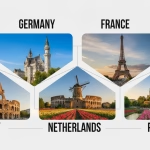If you are curious about Nordic Countries, a region known for its strong economies, innovative businesses, and egalitarian societies, read our comprehensive guide to business statistics and culture in the Nordics.

The Nordic countries (Denmark, Finland, Iceland, Norway, and Sweden) are known for their strong economies, high standards of living, and progressive cultures. These factors make them attractive destinations for businesses of all sizes.
Regarding business statistics, the Nordic countries have a lot to offer. They have high levels of innovation, a well-educated workforce, and a solid commitment to sustainability. The Nordic countries had a combined GDP of over $1.7 trillion and consistently ranked among the most competitive economies in the world.
If the Nordic countries are on your business radar, then it’s best to know the different business cultures of Nordic countries. Let’s get started:
Quick Nordic Countries Facts
| Country | Population | GDP (nominal) | GDP (PPP) | Exports | Imports |
| Denmark | 5.8 million | $362 billion | $459 billion | Machinery, foodstuffs, instruments, packaged medicaments, different types of machinery | Cars, refined petroleum, broadcasting equipment, computers, and passenger and cargo ships. |
| Finland | 5.5 million | $279 billion | $337 billion | Machinery and instruments, chemicals, food, and live animals | Raw materials, energy, food, and consumer goods |
| Iceland | 364,000 | $21.7 billion | $27.2 billion | Fish, aluminum, tourism | Machinery, petroleum products, motor vehicles, and food |
| Norway | 5.4 million | $405 billion | $493 billion | Petroleum and petroleum products, equipment, fish | Machinery, transport equipment, chemicals, and metals |
| Sweden | 10.3 million | $515 billion | $603 billion | Machinery, paper and pulp, iron and steel products, and chemicals | Motor vehicles, chemicals, and food |
Business Culture

The working cultures of Nordic countries showcase a distinct blend of values and practices that contribute to their renowned efficiency and success.
In Norway, the flat structure, emphasis on equality, and a foundation of trust form the bedrock of their business culture. These principles foster a sense of collaboration and drive efficiency, making Norwegian companies efficient and successful.
Punctuality takes center stage in Swedish working culture. Swedes value time highly and punctuality is considered a mark of respect. This punctuality extends to all Scandinavian countries, emphasizing the importance of effectively honoring commitments and managing time. Communication is critical; if delays are inevitable, timely notification is expected.
Finnish business culture exudes pragmatism and formality. The Finns prioritize getting down to business, often favoring direct and transactional interactions. Small talk is minimized, and face-to-face meetings are streamlined, with email as an efficient communication tool. This straightforward approach underscores their commitment to productivity and results.
Denmark’s business landscape is characterized by its flat hierarchy and informal interactions. Addressing colleagues and bosses by their first names and treating each other as equals is customary. This friendly approach promotes open communication and encourages collaboration. Colleagues often socialize outside work, fostering a unique camaraderie and shared purpose.
Iceland strikes a balance between business and personal relationships. Establishing a friendly rapport is essential, as Icelanders intertwine work and leisure. This blend creates a welcoming atmosphere where forging connections and understanding individual motivations drive productive outcomes.
Work Hours
Nordic countries, known for their high standard of living and progressive social policies, have established unique approaches to working hours that contribute to their citizens’ well-being and overall quality of life. Each nation within this region – Norway, Sweden, Finland, Denmark, and Iceland – exhibits distinct working timings and hours, reflecting their cultural values, labor laws, and economic structures.
Often hailed as a model for work-life balance, Norway emphasizes flexible working hours and values leisure time. The standard workweek is typically 37.5 hours, with a strong focus on productivity during work hours. This approach ensures employees have ample time for personal pursuits, family, and recreational activities.
Sweden is renowned for introducing the concept of “lagom,” which translates to “just the right amount.” The Swedish work culture emphasizes efficiency, and the average workweek is around 40 hours. However, the country’s experiment with a 6-hour workday garnered global attention. While not widely adopted, it exemplifies Sweden’s willingness to explore innovative work-hours approaches.
Finland places great importance on work efficiency and employee well-being. The standard workweek is around 40 hours, but the country’s policies encourage remote work and offer generous parental leave, reflecting a commitment to supporting work-life balance and family needs.
Denmark is characterized by its flexible working hours and strong trust between employers and employees. The standard workweek is approximately 37 hours, and a cultural emphasis on creating a conducive environment for both work and personal life contributes to high job satisfaction levels.
Iceland has recently garnered attention for its progressive approach to working hours. The standard workweek is 35-36 hours.
Greeting Style

A firm handshake, accompanied by direct eye contact and a warm smile, is the standard greeting in Norway. This gesture signifies respect and equality. Norwegians often address each other by their first names, promoting a sense of familiarity and camaraderie. It’s common for people to greet with a simple “Hei” (hello) or “God dag” (good day) in formal settings.
In Sweden, a subtle nod or a light handshake is customary. Swedes value modesty and humility. Thus, their greetings are often understated. Addressing others with their first names is common, even in professional settings. “Hej” (hi) or “God Morgon” (good morning) are popular greetings. Swedes are keen on maintaining a balanced personal space, reflecting their respect for individual boundaries.
A nod, a brief smile, and a hearty handshake characterize Finland’s greeting style. The Finnish culture places a strong emphasis on equality and simplicity, which is evident in their greetings. People typically use first names in both formal and informal interactions.
Denmark follows a more relaxed and informal greeting style. A friendly hug, a kiss on the cheek, or a firm handshake are all acceptable ways to greet. Danish people are known for their “hygge” lifestyle, emphasizing comfort and coziness, reflected in their greetings.
A hearty handshake and direct eye contact convey sincerity and respect in Iceland. Addressing others by their first names, even public figures, symbolizes the country’s egalitarian ethos. The Icelandic greeting often includes a genuine inquiry about the other person’s well-being.
Meetings
Meetings in Norway are frequently democratic and inclusive. The decision-making process is collaborative, and everyone’s input is respected. People address one another by their first names to foster equality and a pleasant atmosphere. Meetings are frequently started and ended on time since punctuality is highly valued.
Sweden values agreement and participation. Meetings include open conversations in which all attendees are invited to offer their ideas. Swedes value rigorous planning and well-organized agendas. During conversations, silent pauses are typical to allow for thinking before making conclusions.
Meetings in Finland are fast and focused. The small conversation is kept to a minimum, and discussions are direct. Finns place emphasis on clarity in communication and demand well-organized presentations. Decisions are made methodically, with significant consideration before reaching conclusions.
Denmark maintains a relaxed yet professional meeting atmosphere. Informality is essential, and addressing coworkers by their first names is customary. A relaxed mood frequently distinguishes meetings, yet the gravity of the discussed business issues remains.
Meetings in Iceland are known for their directness and open communication. People express themselves openly, and hierarchy has less impact on talks. Meetings can often take a casual turn without compromising their objective, which is appreciated.
Languages

The percentage of people who speak each language in the Nordic countries varies. In Sweden, about 90% of the population speaks Swedish. In Denmark, about 85% of the population speaks Danish. In Norway, about 80% of the population speaks Norwegian. In Finland, about 90% of the population speaks Finnish.
In addition to these four main languages, there are also several minority languages spoken in the Nordic countries. These include Icelandic, Faroese, Greenlandic, and Sami.
However, you can relax as English is also widely spoken in the Nordic countries. It is the second most common language in Sweden and Norway. The Nordic countries are very open to international trade and cooperation. So speaking English will be enough for corporate purposes if you want to work or do business in the Nordic region.
Dress Code
Nordic countries, including Norway, Sweden, Finland, Denmark, and Iceland, each have unique dress codes influenced by their cultural values and climate.
In Norway, a smart casual approach is common in offices, with formal attire reserved for official events. Men and women often choose well-groomed suits.
Swedes prioritize high-quality clothing and exhibit a blend of casual and formal wear. While workplaces lean towards casual attire, business meetings call for dark formal wear for men and pencil skirts paired with shirts for women. Modesty and simplicity define Swedish dressing norms.
Finland suggests a formal dress code for both genders, yet flexibility depends on company culture. Inquiring about acceptable attire beforehand is advisable.
Denmark adopts a smart and professional dress code, favoring a balance between formality and comfort. Suits are seldom mandatory, showcasing a more relaxed approach.
Iceland stands out with a distinct approach. Unlike the U.S., where dressing up for work is expected, Icelanders often dress down for work and reserve formal wear for special occasions or specific professions like government or banking.
Given Iceland’s fantastic climate, practical clothing choices like sweaters, raincoats, and sturdy shoes are essential year-round.












